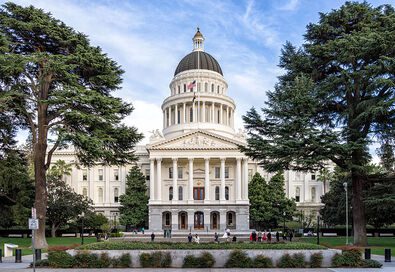 California State Capitol. Photo by Andre_m via Creative Commons.
California State Capitol. Photo by Andre_m via Creative Commons.
In a move that he likened to “pulling the emergency brake” and “moving from a marathon to a sprint,” Newsom made Marin one of 40 California counties to tighten restrictions in response to a surge of COVID-19 cases across the state. Effective immediately, Newsom moved Marin from the less restrictive orange tier to the more restrictive red tier within the statewide Blueprint for a Safer Economy COVID-19 framework.
That means, effective Nov. 17:
- Restaurants are allowed outdoor service only
- Retail establishments are allowed at 50% capacity
- Office workspaces are allowed for essential workers; nonessential workers should work remote only
- Bars and breweries closed unless serving full meals outdoors
- Wineries are allowed outdoor service only
- Personal care services are allowed indoors
- Places of worship are allowed at 25% capacity or 100 people (whichever is fewer)
- Libraries are allowed at 50% capacity
- Movie theaters are allowed at 25% capacity or 100 people (whichever fewer) – Cinemarts Sequoia remains closed
- Gyms and fitness centers are allowed at 10% capacity
- Indoor pools are not allowed
Not that it’s any consolation, but Marin avoided (so far) being one of the 28 counties moved into the purple Tier 1, the most restrictive status on the Blueprint scale, because of widespread virus spread. Marin is now one of 11 counties out of 58 in red Tier 2 status; 41 are in purple Tier 1.
“This is concerning because surges are happening just as the weather is getting cooler, and before the real holiday season even starts,” Willis said. “We can anticipate more travel, more gatherings, more flu. If we don’t get in front of this now, I’m concerned about our hospital capacity to manage cases come December.”
One week ago, citing a rise in transmission and hospitalizations across the Bay Area, Willis joined with his health officer cohorts to tighten local rules for higher-risk indoor activities where the virus can spread more easily. On Nov. 10, he recommended that Marin restaurants reduce their indoor dining capacity to 25 percent density, down from the 50 percent density approved on Oct. 27 as part of Marin’s move into the less restrictive orange tier.
In Marin, case rates have continued to spike, rising by an average of more than 23 new cases per day over the past week, according to Marin HHS data.
A full list of changes to business sector guidelines will be updated to the Marin Recovers websitesoon. All open businesses must complete a COVID-19 Site-Specific Protection Plan prior to reopening under Tier 2 restrictions. Guidance for the plan also is found on the Marin Recovers website.
Mill Valley School District officials indicated the tier changes could affect Marin’s school reopening process. Marin schools started re-opening on September 8, but Mill Valley’s five elementary schools are set to open Nov. 30 for half-day, in-person learning. If the county remains in the red tier or higher, that planned re-opening will continue, but if the county moves to the purple tier before November 30, 2020, MVSD schools will be unable to open and would then target Jan. 11, 2021, assuming health conditions allow. If we are unable to open on November 30th, all learning will remain as is in current Distance Learning.
Daily case reports are rising in 48 states, according to the New York Times, and “with little action from the Trump administration, governors and mayors across the country are taking new steps to try to halt the spread.
Much of the recent rise in cases, state officials say, appears to have grown from at-home parties or family gatherings.
Dr. Bob Wachter, a professor and chair of UCSF’s department of medicine, told the Times that the moves by the state seemed prudent in light of rising case numbers. “This strikes me as a reasonable set of actions, particularly with Thanksgiving coming up,” he said. “Whether or not it’s enough, I guess we’ll see.”
